Seguridad de la marca en anuncios y medios sociales [Guía 2025]
Índice
Imagine spending months designing your brand campaign. Everything is perfect — the copy, the visuals, the target audience. And then, just after launch, your ad appears next to a viral post filled with hate speech. Even though your brand has nothing to do with that content, people start to perceive it negatively. That’s exactly what brand safety is about — ensuring your brand appears in the right places and reflects the values and identity you’ve worked so hard to build.
- Brand safety refers to all measures that protect a brand’s image and reputation from the negative or damaging influence in advertising and the social media landscape.
- It’s important for multiple reasons, including maintaining customer trust, avoiding legal risks, strengthening brand consistency, y preventing crises.
- Regardless of whether in advertising or social media, brand safety measures always require careful preparation and a practical approach, combining clear guidelines, the right tools, and ongoing monitoring.
¿Qué es la seguridad de las marcas?
Seguridad de marca refers to a set of practices and strategies designed to protect a brand’s reputation by keeping it away from harmful or unsuitable content.
Traditionally, the term has been used in the advertising world, focusing on keeping ads away from harmful, offensive, or misleading environments.
However, in the era of social media and generative AI, brand safety now extends to monitoring how a brand is mentioned, discussed, and represented online.

In the advertising context, brand safety is achieved through:
- Setting clear brand standards and suitability guidelines
- Managing inclusion and exclusion lists
- Utilizing contextual targeting
- Applying third-party verification.
In the social media context, brand safety is achieved through:
- Establishing crisis management procedures.
- Setting communication tone and moderation rules
- Monitoring online mentions and análisis de opiniones
- Vetting influencer and partner collaborations
How to strengthen brand safety in advertising?
01 Establish brand standards and suitability guidelines
The best way to address brand safety concerns is to set clear guidelines for your digital advertising. Start by defining what your brand considers unsafe or inappropriate.
Beyond the obviously risky stuff – like conspiracy theories, fake news, or criminal activity – think about which topics, language, or visuals don’t align with your brand’s image.
In this place, it’s worth underlining the difference between brand safety and brand suitability.
Brand safety vs. Brand suitability table
| Categoría | Seguridad de marca | Brand suitability |
| Objetivo | Avoid content that is universally recognized as harmful. | Align ad placements with brand values and tone. |
| Enfoque | Universal “unsafe” content (e.g., hate speech, violence, illegal activity). | Contexts that fit or enhance the brand’s image and audience expectations. |
Brand suitability examples
A vegan food-selling brand probably shouldn’t show up next to a video promoting steak recipes, even if it’s not universally harmful. It just contradicts the vegan brand’s values.
Similarly, a LEGO ad shouldn’t precede a YouTube video titled “How to Choose the Right Condom?”. Do I really need to explain why?
Moreover, as not all content is equally risky, you should set up a risk tolerance range.
In practice, categorize it into low, moderate, and high-risk zones. This creates a clear framework showing you where you need strict control and where your brand can be more flexible.
02 Create inclusion and exclusion lists
Every ad platform gives you some control over where your ads appear. And that’s where inclusion and exclusion lists come in:
- En inclusion list (also called a whitelist) is a list of trusted websites, apps, or channels where you want your ads to show. Think of it as your brand’s safe zone where you know your message will fit right in.
- En exclusion list (or blacklist) does the opposite. It tells the platform where not to place your ads. For example, there are low-quality sites, controversial forums, or content categories that just don’t match your values.
By managing these lists, you ensure that your ad budget goes only toward placements that support your image and reach the right audience.
It’s one of the simplest yet most effective ways to build a strong foundation for brand safety.
03 Use contextual targeting
Contextual targeting is the practice of placing ads based on the content and context of a webpage, ensuring they appear in environments that align with your brand’s values and message.
In other words, contextual targeting is a strategy based on analyzing the entire page (including topic, tone, and meaning) to determine whether it’s a good match for your brand.
Of course, it’s not manual work at all. Modern, AI-driven tools can distinguish between positive, neutral, and negative contexts and place your ad accordingly.
For instance, an ad for a cycling app would naturally fit within a YouTube search result about how to prepare for a triathlon, but would feel out of place next to a story about a sports injury.
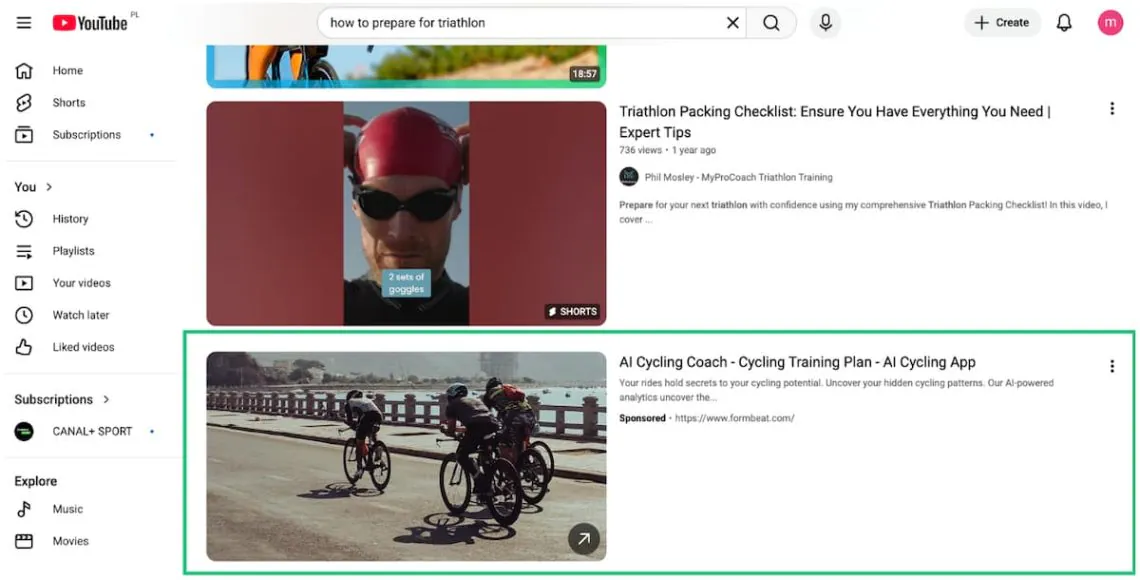
Contextual targeting doesn’t just protect your brand – it can also improve performance.
When your ads appear in the right places, they feel more relevant and trustworthy, which often boosts engagement.
04 Integrate third-party verification
Even with the best settings and lists, it’s hard to monitor every single ad placement on your own. That’s where third-party verification tools enter the stage.
These independent platforms, like Integral Ad Science (IAS), DoubleVerifyo Moat, act as an extra layer of protection.
En track where your ads appear in real time and flag anything that doesn’t meet your brand safety standards.
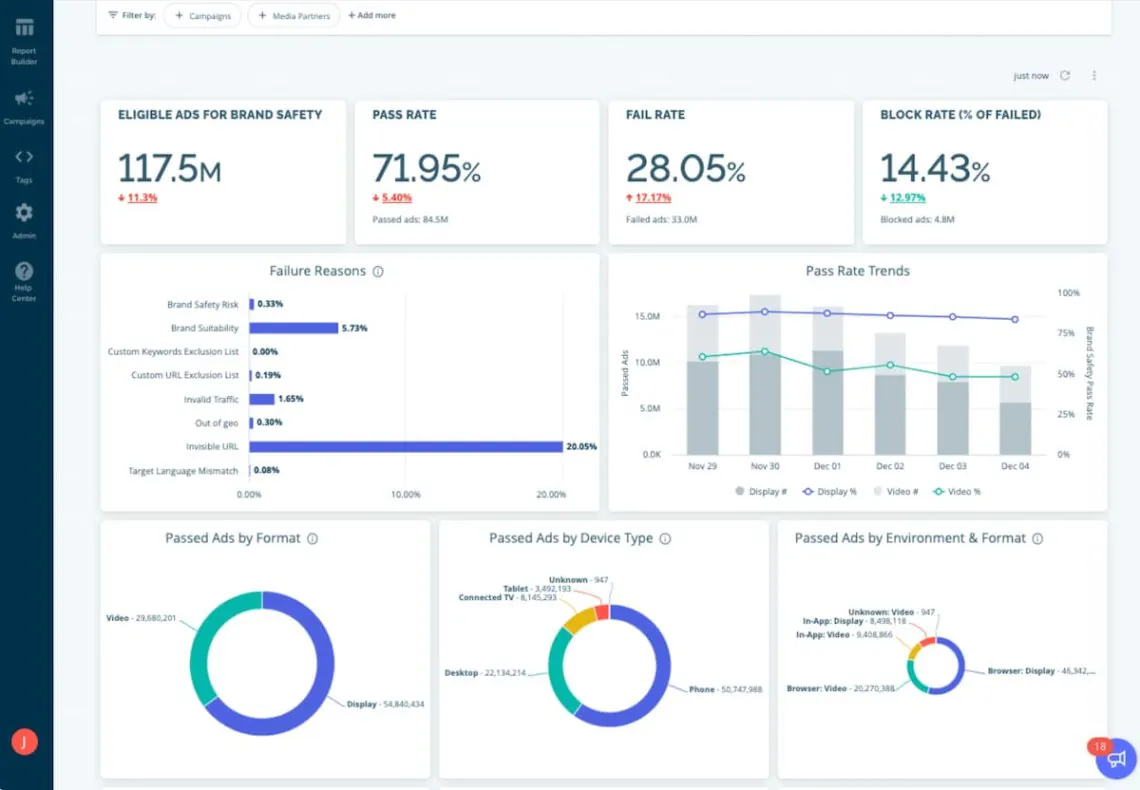
In other words, they double-check that your ads are showing up in the right places. Most of these tools also provide detailed reports, showing which placements were blocked, flagged, or verified as safe.
💡 Pro tip
If you’re running large-scale campaigns, integrate verification directly into your ad platform (for example, Google’s Display & Video 360 connects with IAS and DoubleVerify).
It’ll save time, automate insights, and help you catch potential issues before they become real problems.
How to strengthen brand safety in social media?
01 Set communication tone and moderation rules
A consistent y well-defined communication tone is the foundation of brand safety on social media.
Decide how your brand voice and communication. Should you sound formal or friendly? Witty or serious? Clearly outline what types of language, humor, and visuals are acceptable.
Equally important are moderation rules. Define how your team handles comments and interactions: when to reply, when to hide or delete, and when to escalate.
Having these rules in place helps you stay calm and consistent even when online discussions get emotional.
Más información: Best brand safety tools
02 Monitor brand mentions and sentiment
You can’t ensure brand safety if you don’t know what people are saying about your brand.
Regularly tracking mentions across social media platforms helps you catch early signs of negative sentiment, misinformation, or even a brand crisis.
In practice, you can use AI-powered herramientas de escucha social como Brand24. They allow you to monitor social and non-social media mentions, understand their tone and context, and detect anomalies.
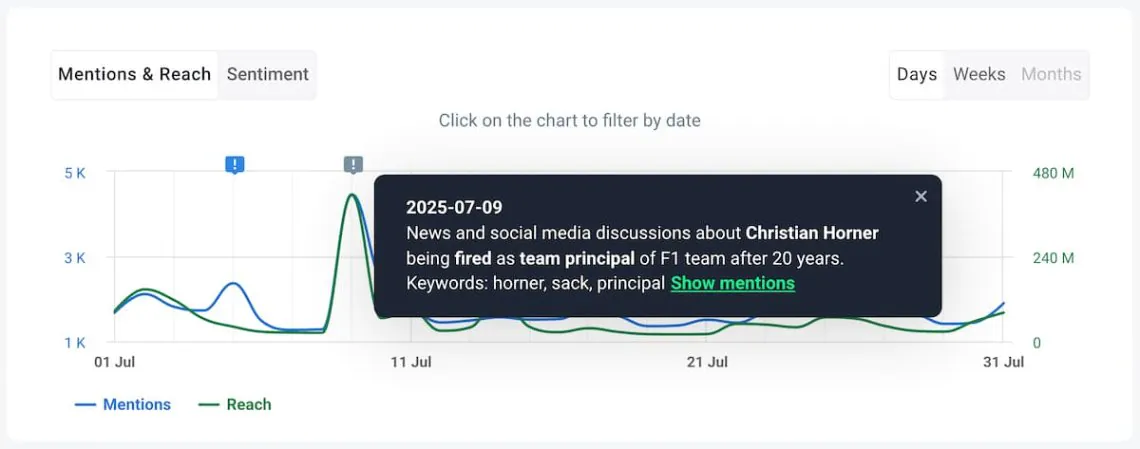
With such knowledge, you can react before issues escalate. Early detection allows you to correct misinformation, respond to criticism, and join a conversation before it goes into a negative direction.
In many cases, timely and transparent communication not only prevents a crisis but also strengthens trust, showing that your brand listens and cares about its audience.
Según Barómetro de confianza de Edelman, 65% of customers claim that a brand’s response in the crisis tiene un huge impact on their likelihood of purchasing from it in the future.
Monitoring sentiment over time also helps you identify recurring pain points or topics that spark strong emotions.

These insights are valuable also beyond brand safety, they can inform your communication strategy, customer support tone, and even product decisions.
03 Verify influencer and partner content
Influencer collaborations can boost your brand’s reach and credibility, but they also come with risks.
Before you sign any partnership, take the time to review the influencer’s previous content, tone, audience, and alignment with your brand values.
Look for potential red flags, such as controversial opinions, insensitive jokes, or mismatched values.
Once the campaign is live, continue monitoring their posts to ensure your brand remains associated with the right messages.

A thoughtful verification and control process protects both your reputación de marca and your investment.
04 Prepare for a crisis management
The ancient Roman writer Vegetius once said: Si vis pacem, para bellum – “If you want peace, prepare for war.” The same applies to brand safety.
No matter how careful you are, social media crises can happen unexpectedly. A misunderstood post, a reckless campaign, or an influencer scandal can quickly escalate.
That’s why every brand should have a plan de gestión de crisis en las redes sociales en su sitio.
Define clear roles and responsibilities:
- Who monitors the situation,
- Who communicates with the public,
- Who gives final approval for responses.
Prepare message templates and escalation procedures in advance, so your team can react quickly without losing its tone of voice or accuracy.
Speed and transparency are crucial during a crisis. A prompt, empathetic response can prevent further damage, while silence or defensive communication often makes things worse.
Remember that people don’t expect perfection. They expect honesty and accountability.
PREGUNTAS FRECUENTES
¿Por qué es importante la seguridad de las marcas?
- Protect brand reputation: Una mala ubicación de los anuncios perjudica la percepción de la marca.
- Generar confianza en el cliente: Los anuncios inseguros erosionan la confianza, que es difícil de recuperar.
- Impacto financiero: Los anuncios mal ubicados malgastan el presupuesto y perjudican las ventas.
- Riesgos jurídicos: Los anuncios inapropiados pueden acarrear sanciones legales.
- Participación del público: Un contexto publicitario deficiente reduce la participación y el ROI.
- Ventaja competitiva: Fuerte apoyo a la seguridad de la marca fomentar la fidelidad a la marca y le ayuda a ganar con otras empresas del sector.
- Coherencia global: Ensure safety across markets despite cultural / legal differences.
- Prevención de crisis: La idoneidad de la marca y una gestión adecuada de los contenidos evitan desastres de relaciones públicas.
- Responsabilidad social: Apoye las prácticas éticas mediante la elección de anuncios.
- Asociaciones: Las marcas fiables atraen mejores colaboraciones.
What are brand safety risks in advertising?
Due to the programmatic nature of digital advertising and the scale of user-generated content, there are numerous risks to brand safety.
Here are the most common ones:
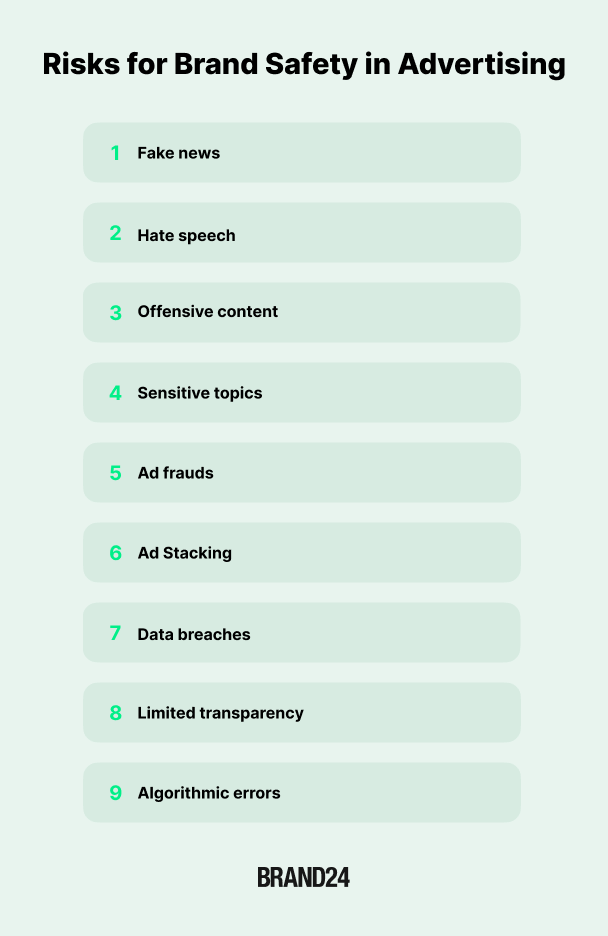
- Misinformation and fake news
When your brand ad is displayed next to the fake or misleading information. - Hate speech and extremist content
When your brand ad is displayed on websites or channels that promote extremist content, hate speech, or politically charged material. - Inappropriate or offensive content
When your brand ad is displayed next to graphic violence, sexually explicit material, obscenity, and profanity. - Sensitive topics
When your brand ad is displayed in the proximity of sensitive topics like death, tragedy, crime, or military conflict. While it’s not directly offensive, it can create a negative brand image. - Ad fraud and bot traffic
Fraudulently used bots and automated scripts can generate fake clicks and impressions, leading to overspending of advertising budgets and misleading performance data. Very harmful for marketing efforts. - Domain spoofing
Fake websites or email domains that look legitimate to deceive advertisers and serve their ads in unsafe environments. - Ad stacking
Multiple ads on top of one another, while only the top ad is visible. Such a situation causes the publisher to still receive revenue for all the invisible ones, and advertisers pay for ads that no one can see. - Data privacy breaches
The unauthorized collection, storage, or sharing of user data can undermine customer trust and lead to legal violations and fines. - Limited transparency
Some programmatic advertising partners offer limited transparency, making it difficult for brands to verify exactly where their ads are being placed. - Algorithmic errors
The algorithms that determine ad placement can fail, creating embarrassing or inappropriate contextual mismatches. This is sometimes referred to as “malgorithms”.
What are brand safety risks in social media?
While advertising risks usually result from automated placements and algorithms, social media risks are driven by human behavior and real-time interactions.
Here are the most common brand safety risks in social media:
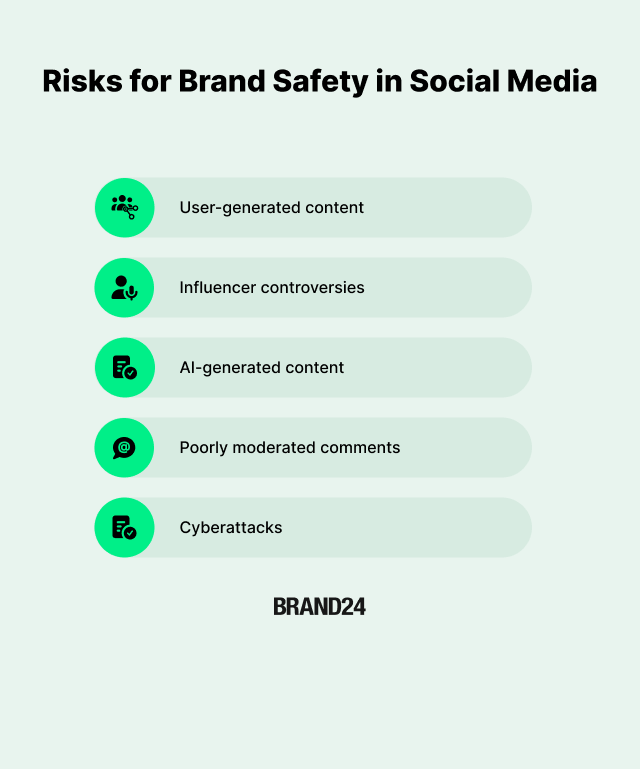
- User-generated content (UGC)
On platforms like YouTube, TikTok, and Twitch, ads can be placed before, during, or after user-generated videos. This content is difficult to moderate in real-time, which increases the risk of an ad appearing next to harmful material. - Controversial creators and influencers
Cooperation with an influencer who shares controversial opinions, behaves inappropriately, or causes negative sentiment can lead to backlash, even if your campaign with them is well-planned.

- Contenidos generados por IA
The rise of generative AI introduces new risks, including deepfakes and deceptive AI content. This category includes multiple technologies, like face swap, voice cloning, or AI impersonation. - Poorly moderated comments
Offensive or inappropriate comments can appear directly on a brand’s paid ads or organic content, creating a negative sentiment for the brand. - Cyberattacks
Phishing attacks, account takeovers, or posting harmful content from the brand’s official accounts.
Conclusión
Brand safety requires clear thinking and consistent action. It’s not only about avoiding harmful environments but also about choosing the ones that really reflect your brand’s values.
In advertising, that means setting precise standards, managing lists, using contextual targeting, and implementing verification tools.
On social media, it means defining your tone, monitoring sentiment, vetting partnerships carefully, and creating a crisis management guideline.
By treating brand safety as a long-term process (not a one-time fix) you build stronger trust and protect your brand’s integrity in every channel.
Reflexiones finales:
- Prevention is always cheaper and easier than crisis control
- Transparency from partners and platforms builds safer ecosystems.
- Brand safety is not about fear or paranoia. It’s about smart, proactive control.
Iniciar una prueba gratuita de 14 días de Brand24 and keep your brand safe!




